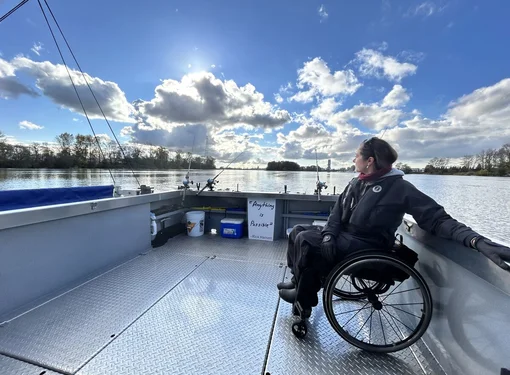Accessible cities: How New Westminster is leading the way (Part 1)
Above image: Downtown New Westminster, British Columbia, with the SkyTrain passing by above the street. (Credit: Wikimedia Commons)
The Greater Vancouver area is full of individual smaller municipalities. In fact, the majority of Metro Vancouver's population lives outside of the City of Vancouver itself.
So it is not surprising that accessibility can sometimes vary from city to city.
One city that gained attention recently for its efforts is New Westminster. Located 19 kilometres southeast of Vancouver, it was the first capital city of the province of British Columbia and is full of historical landmarks. Today, it also boasts a bustling industrial centre along the Fraser River.
Recently, we had a chance to ask Mayor Jonathan X. Coté some questions about the city's accessibility initiatives.
1. What inspired you to make accessibility a major focus?
New Westminster, similar to other municipalities in Metro Vancouver and the Province, is experiencing an aging population. In 2011, there were 8,845 people over 65 years old, which represented 13.4% of the population. In 2036, there are projected to be 20,947 people over 65 years old, which will represent 21.4% of the population.
People over 65 years old have far high rates of activity limitations, with 58.1% reporting a limitation. While the percentages are far lower, people under the age of 65 also report activity limitations, with 17.5% reporting a limitation.
As such, accessibility, in its broadest sense, will become increasingly important to ensuring that residents can live as independently as possible, can age in place, can actively participate in the community and can make a meaningful contribution.
 Above image: New Westminster is the oldest city in western Canada and has many heritage buildings such as this one. (Credit: Wikimedia Commons)
Above image: New Westminster is the oldest city in western Canada and has many heritage buildings such as this one. (Credit: Wikimedia Commons)
2. What are some of the challenges you faced while creating an accessible city?
New Westminster is the oldest city in western Canada and is home to large numbers of heritage buildings. As such, the infrastructure is also older and was developed during a time when accessibility was not such an important consideration. Many heritage buildings incorporate stairs, with only a few older commercial buildings being served by elevators.
The City, in response, has been aggressively replacing and retrofitting its infrastructure, including parks, public plazas and sidewalks, to enhance accessibility, comfort and safety.
For example, the Pier Park, which is strategically located on the city's waterfront, is now served by a pedestrian overpass and elevator, which facilitates universal accessibility.
Being an older city also has some advantages. The city already has an extensive network of sidewalks and the smaller size of the city blocks contributes to shorter walking distances. This is evident by the fact that 36% of trips made by residents are by walking, cycling or using transit.
The City is looking to increase this level of sustainable transport by improving accessibility. On an annual basis, the City contributes $375,000 towards sidewalk upgrading and replacement, including curb letdowns and other accessibility features.
Given that the city is experiencing rapid growth and development, developers, through works and services agreements, are also contributing to upgraded infrastructure, including sidewalk replacement.
 Above image: One of the upgraded sidewalks in uptown New Westminster. (Credit: Wikimedia Commons.)
Above image: One of the upgraded sidewalks in uptown New Westminster. (Credit: Wikimedia Commons.)
3. What are you hoping that other cities can gain from New Westminster's example?
Since 2007, the City has been working towards an Age and Ability Friendly City, which encourages active aging and inclusion by optimizing opportunities for health, participation and security to enhance quality of life. In practical terms, such a city adapts its structures and services to be accessible to and inclusive of people with varying needs and capacities.
To this end, the City has prepared a Seniors Engagement Toolkit, which helps to ensure that municipal planning processes are inclusive of the viewpoints and needs of seniors, including on issues related to accessibility.
The City also conducted a Wheelability Assessment Project, which involved seniors and people with mobility limitations in assessing the built environment in order to enhance accessibility.
Additionally, the City developed an Adaptable Housing Policy and Bylaw, which requires that 40% of new, single-storey, multi-family housing be adaptable.
On January 26, 2015, City Council participated in Dementia-Friends training and, in the process, became the first Dementia-Friendly City Council in British Columbia. The City is also working on a Dementia-Friendly Community Action Plan.
The City is committed to planning with and not for seniors and people with disabilities. In this way, they feel empowered and City staff can be sure that their voice is being heard and that their diverse needs are being met.
It is this commitment to community development and empowerment that is probably the best advice that could be offered to other municipalities.
Click to see Part 2 of our discussion with Mayor Jonathan Coté!






